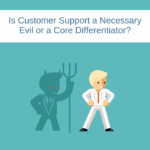Which Customer Service Predictions Came True from 3 Years Ago?

Ever try to predict the outcome of anything? It’s no easy feat. Sci-fi author Arthur C. Clarke said predictions about the future can be a “discouraging, hazardous occupation.” Either you sound believable, but are proved pitifully shortsighted or you sound loony, and are proven right too late. For prediction-makers, it’s often lose-lose.
But we’ve been wondering if you look at a shorter window for customer service predictions, say three years ago, who would prove right and who would miss the mark? Here are the customer service predictions that caught our eye the most.
Prediction: 80% of Multichannel Implementations Will Fail (Source: Gartner)
In 2012, Gartner made a bold, rather dismal prediction. Gartner analysts claimed 80% of multichannel implementations would fail because businesses would apply single channel strategies to multichannel challenges. We were hoping most companies knew better (yeah, we’re optimists), however, in this particular case, the prediction holds water.
Cisco found plenty of instances of multichannel frustration. In a survey they conducted, there appeared to be little efficacy with multichannel customer service. In fact, 89% of people reported aggravation at having to repeat themselves across channels with multiple customer reps. It begs the question, does it come from a poor understanding of multichannel strategies? Additional data makes us think yes.
Statistics gathered by EvaluAgent find that as high as 90% of businesses lack a clear view of the customer’s journey across channels. Continuity across interactions and channels is the secret sauce to any exceptional contact management team. It keeps satisfaction high and customer effort levels low.
For a business to acquire that 360° view of every channel takes time, robust technology, air tight processes, copious data, and a fully equipped customer service arm. Otherwise, your lifetime customer value may last as long as the flavor in a stick of Fruit Stripe gum.
Prediction: 60% of Customers Will Use Social Media Communication Channel (source: IBM)
IBM predicted in 2012 that social media would further pervade our lives. At the time, only 16% of customers were using social media platforms as a channel for connecting with brands. But through some shrewd analysis of client data, IBM confidently guessed that 60% of customers would soon be using that channel.
That’s a pretty radical jump. What made them so confident? IBM saw the sea change coming in waves as customers interactions pointed to new habits of interaction. At the time, there were 1.47 billion social media users out in the big wide world. It seemed only logical that they’d take their complaints and questions to social media.
Moreover, IBM found that of 1,700 CEOs, the majority were allocating resources from traditional phone and email channels to social media support. That looked auspicious. And though most companies were astute enough to get a running start, many flopped with the execution of social media customer service – which actually turned customers away.
With the exception of the airline industry, 70% of businesses with social media accounts have been decried as neglecting customer complaints on social media. That’s kept social media customer service stagnant. For example, last year social media was barely a drop in the bucket when customers listed preferred contact methods. Live phone (33.5%) and email (32.5%) customer service were first and second and social media (a nominal 2%) was stuck in dead last.
The bottom line: social media may not have grown to reach the popularity predicted by IBM, but it still remains an influential piece of the pie. It’s highly visible and, if neglected, can do potential damage throughout a complaining customer’s social media following.
Prediction: Budgets for Increasing Loyalty with Customer Service Will Double (Source: Gartner)
As a company that makes its living on predicting and advising, Gartner predicted that budgets for customer retention and loyalty programs would double due to the adoption of new channels like live chat and social media. Growth was also expected in the new support channel and that departments would grow with them.
For the most part, those budgets have grown on pace with economic indicators, but from our viewpoint here in 2015, customer experience is king. Investment in a better customer experience is where we are seeing smart, customer-centric organizations evolve their budgets and adapt their spending as they accommodate new aspects of the customer journey.
Gartner’s 2013 prediction of budgets doubling has not panned out for the majority of established organizations (start-ups are a different beast altogether.) But Gartner took another stab at it and recently predicted an incremental budgetary increase of 8% over the course of the next year. If we were the betting kind, we’d be willing to back this most recent Gartner prediction.
In today’s customer service environment where a differentiated customer experience can make or break your business, there is constant pressure to do more and do it better. For most companies, there is always going to be a debate about what to handle internally and what to outsource in order to maximize your customer service budget ROI. Now is the time to invest in your customer experience and customer journey – and a strong partnership with the right contact center may get you the best bang for your buck. We are willing to get in the prediction game ourselves and say, three years from now, the leader board is going to be top heavy with companies that take the customer journey seriously and whose budgets reflect the customer experience as a priority.
What These Predictions Mean For Your Contact Center
Customer service is in a moment of disruption. Plenty of businesses are scrambling through the multichannel sphere, searching for the right formula. Social media is getting the short stick. Despite all that, it’s clear that a healthy customer experience has evolved beyond the phone channel, making customer service less of a cost center and more of an opportunity to capitalize on new methods of interaction.
While businesses mismanage ever-evolving multichannel expectations, those businesses with an experienced, tech-savvy contact center team will come out on top. They’ll retain more customers and potentially pick up those from ill-equipped competitors. And whether you do that on your own or through an outsourced contact center partner, it’s well worth the money.
At Blue Ocean, we know the multichannel experience inside and out. If you’re looking for a contact center that can help you create customer service continuity, don’t hesitate to contact us today.



